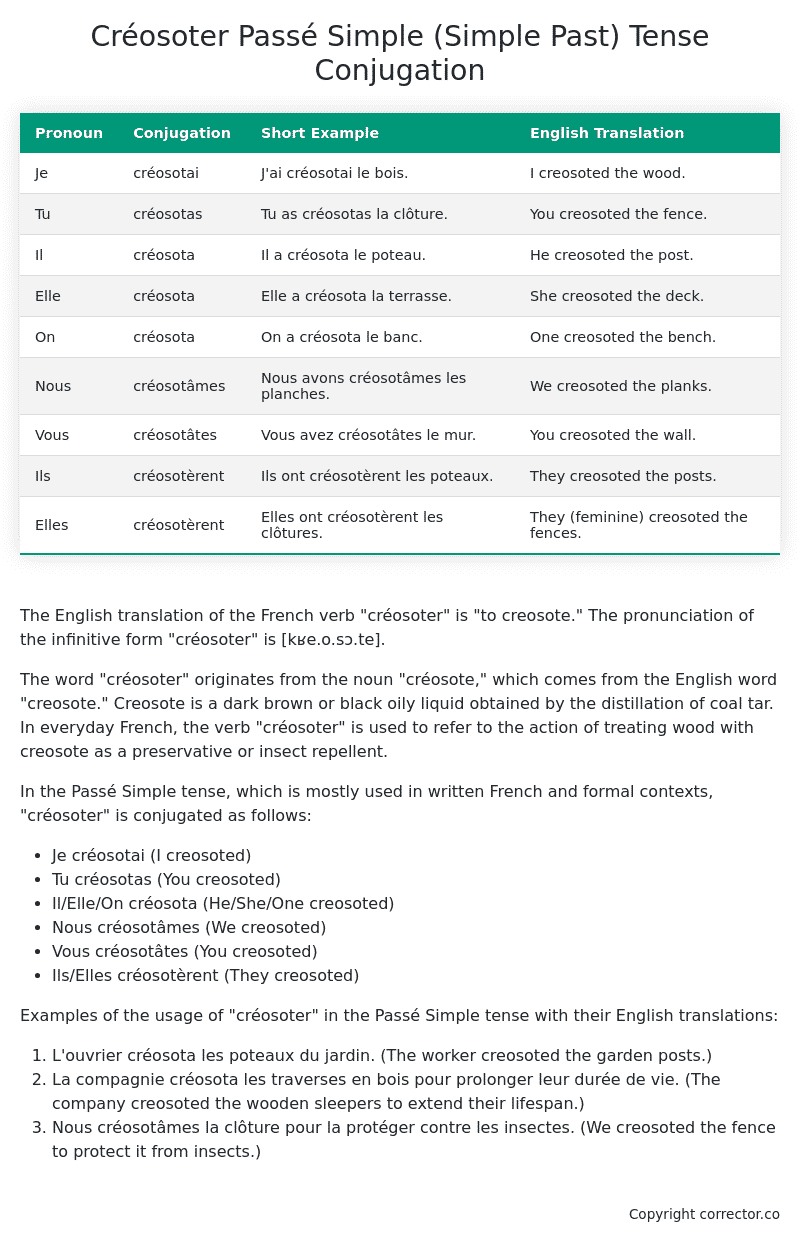Passé Simple (Simple Past) Tense Conjugation of the French Verb créosoter
Introduction to the verb créosoter
The English translation of the French verb “créosoter” is “to creosote.” The pronunciation of the infinitive form “créosoter” is [kʁe.o.sɔ.te].
The word “créosoter” originates from the noun “créosote,” which comes from the English word “creosote.” Creosote is a dark brown or black oily liquid obtained by the distillation of coal tar. In everyday French, the verb “créosoter” is used to refer to the action of treating wood with creosote as a preservative or insect repellent.
In the Passé Simple tense, which is mostly used in written French and formal contexts, “créosoter” is conjugated as follows:
- Je créosotai (I creosoted)
- Tu créosotas (You creosoted)
- Il/Elle/On créosota (He/She/One creosoted)
- Nous créosotâmes (We creosoted)
- Vous créosotâtes (You creosoted)
- Ils/Elles créosotèrent (They creosoted)
Examples of the usage of “créosoter” in the Passé Simple tense with their English translations:
- L’ouvrier créosota les poteaux du jardin. (The worker creosoted the garden posts.)
- La compagnie créosota les traverses en bois pour prolonger leur durée de vie. (The company creosoted the wooden sleepers to extend their lifespan.)
- Nous créosotâmes la clôture pour la protéger contre les insectes. (We creosoted the fence to protect it from insects.)
Table of the Passé Simple (Simple Past) Tense Conjugation of créosoter
| Pronoun | Conjugation | Short Example | English Translation |
|---|---|---|---|
| Je | créosotai | J’ai créosotai le bois. | I creosoted the wood. |
| Tu | créosotas | Tu as créosotas la clôture. | You creosoted the fence. |
| Il | créosota | Il a créosota le poteau. | He creosoted the post. |
| Elle | créosota | Elle a créosota la terrasse. | She creosoted the deck. |
| On | créosota | On a créosota le banc. | One creosoted the bench. |
| Nous | créosotâmes | Nous avons créosotâmes les planches. | We creosoted the planks. |
| Vous | créosotâtes | Vous avez créosotâtes le mur. | You creosoted the wall. |
| Ils | créosotèrent | Ils ont créosotèrent les poteaux. | They creosoted the posts. |
| Elles | créosotèrent | Elles ont créosotèrent les clôtures. | They (feminine) creosoted the fences. |
Other Conjugations for Créosoter.
Le Present (Present Tense) Conjugation of the French Verb créosoter
Imparfait (Imperfect) Tense Conjugation of the French Verb créosoter
Passé Simple (Simple Past) Tense Conjugation of the French Verb créosoter (You’re reading it right now!)
Passé Composé (Present Perfect) Tense Conjugation of the French Verb créosoter
Futur Simple (Simple Future) Tense Conjugation of the French Verb créosoter
Futur Proche (Near Future) Tense Conjugation of the French Verb créosoter
Plus-que-parfait (Pluperfect) Tense Conjugation of the French Verb créosoter
Passé Antérieur (Past Anterior) Tense Conjugation of the French Verb créosoter
Futur Antérieur (Future Anterior) Tense Conjugation of the French Verb créosoter
Subjonctif Présent (Subjunctive Present) Tense Conjugation of the French Verb créosoter
Subjonctif Passé (Subjunctive Past) Tense Conjugation of the French Verb créosoter
Subjonctif Imparfait (Subjunctive Imperfect) Tense Conjugation of the French Verb créosoter
Subjonctif Plus-que-parfait (Subjunctive Pluperfect) Tense Conjugation of the French Verb créosoter
Conditionnel Présent (Conditional Present) Tense Conjugation of the French Verb créosoter
Conditionnel Passé (Conditional Past) Tense Conjugation of the French Verb créosoter
Conditionnel Passé II (Conditional Past II) Tense Conjugation of the French Verb créosoter
L’impératif Présent (Imperative Present) Tense Conjugation of the French Verb créosoter
L’impératif Passé (Imperative Past) Tense Conjugation of the French Verb créosoter
L’infinitif Présent (Infinitive Present) Tense Conjugation of the French Verb créosoter
L’infinitif Passé (Infinitive Past) Tense Conjugation of the French Verb créosoter
Le Participe Présent (Present Participle) Tense Conjugation of the French Verb créosoter
Le Participe Passé (Past Participle) Tense Conjugation of the French Verb créosoter
Struggling with French verbs or the language in general? Why not use our free French Grammar Checker – no registration required!
Get a FREE Download Study Sheet of this Conjugation 🔥
Simply right click the image below, click “save image” and get your free reference for the créosoter Passé Simple tense conjugation!

Créosoter – About the French Passé Simple (Simple Past) Tense
Formation
Usage
Narration
Historical Context
Interactions with other tenses
Passé Composé
Imparfait
Conditional and Subjunctive
Summary
I hope you enjoyed this article on the verb créosoter. Still in a learning mood? Check out another TOTALLY random French verb conjugation!


